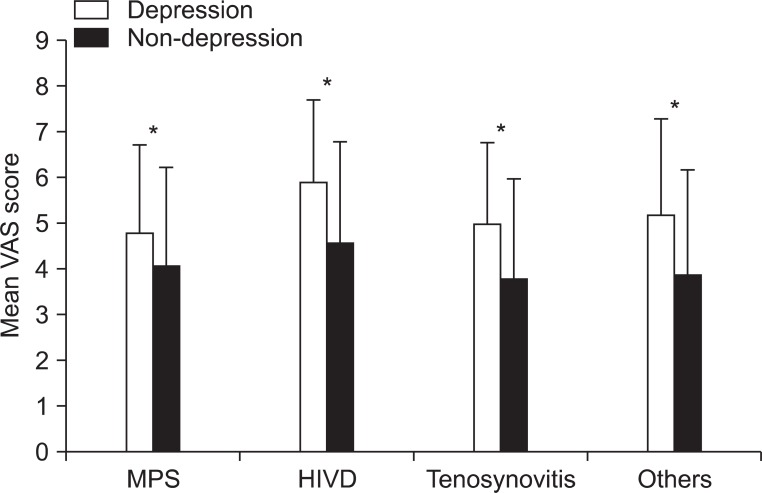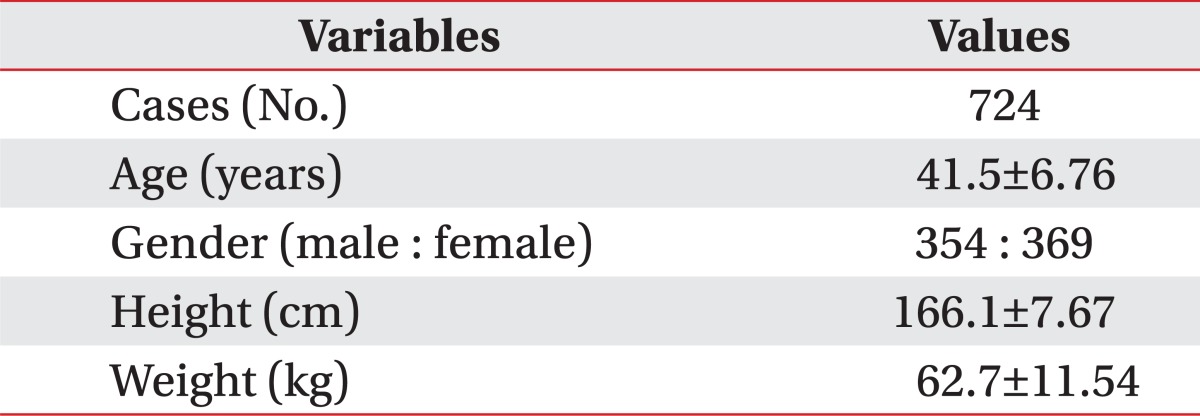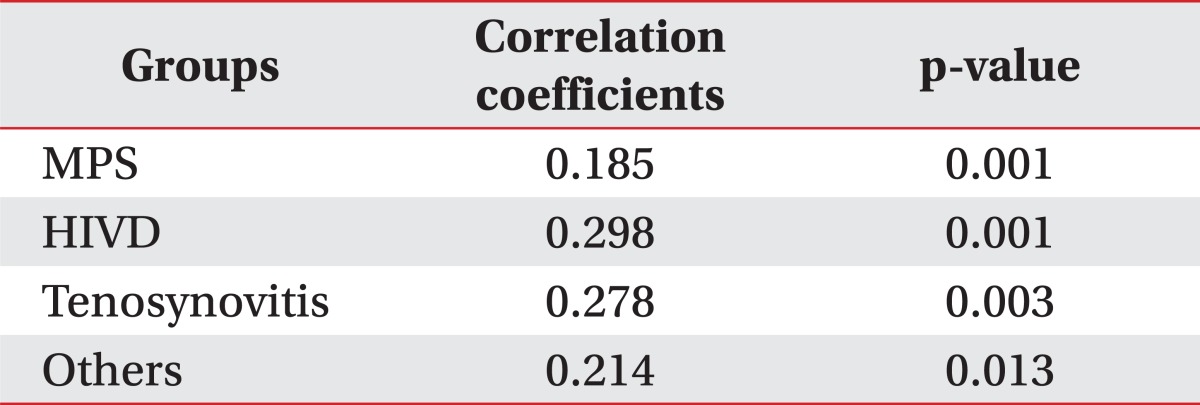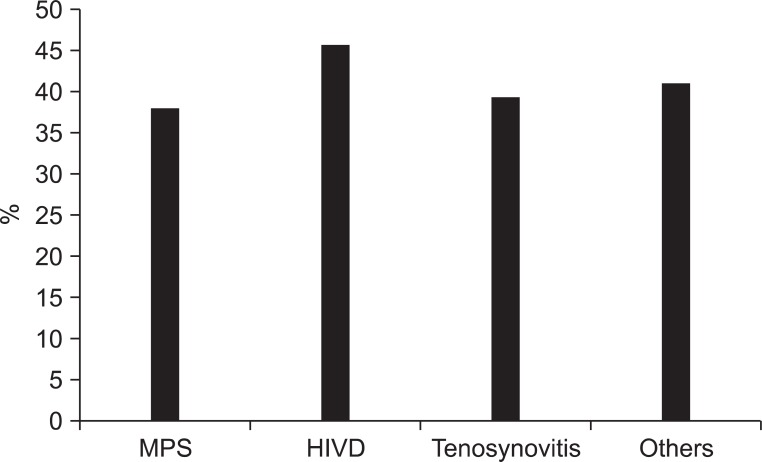1. Lee EC, Kim HC, Jung DY, Kim DH, Leem JH, Park SG. Association between job-stress and VDT Work, and musculoskeletal symptoms of neck and shoulder among white-collar workers. Korean J Occup Environ Med. 2007; 19:187–195.

2. Yoo WG, Yi CH, Kim MH. Effects of a proximity-sensing feedback chair on head, shoulder, and trunk postures when working at a visual display terminal. J Occup Rehabil. 2007; 16:631–637. PMID:
17086500.

3. Kang YK. Evaluation and management of chronic pain. J Korean Acad Fam Med. 2003; 24:103–111.
4. Shin YK, Lee CU. Depressive disorder in patients with chronic pains. J Korean Pain Soc. 2002; 15:110–115.
5. Patten SB, Williams JV, Wang J. Mental disorders in a population sample with musculoskeletal disorders. BMC Musculoskelet Disord. 2006; 7:37. PMID:
16638139.

6. Harter M, Reuter K, Weisser B, Schretzmann B, Aschenbrenner A, Bengel J. A descriptive study of psychiatric disorders and psychosocial burden in rehabilitation patients with musculoskeletal diseases. Arch Phys Med Rehabil. 2002; 83:461–468. PMID:
11932846.
7. Arnold LM, Witzeman KA, Swank ML, McElroy SL, Keck PE. Health-related quality of life using the SF-36 in patients with bipolar disorder compared with patients with chronic back pain and the general population. J Affect Disord. 2000; 57:235–239. PMID:
10708837.

8. Rundall TG, Shortell SM, Wang MC, Casalino L, Bodenheimer T, Gillies RR, Schmittdiel JA, Oswald N, Robinson JC. As good as it gets? Chronic care management in nine leading US physician organisations. BMJ. 2002; 325:958–996. PMID:
12399351.

9. Grevitt M, Pande K, O'Dowd J, Webb J. Do first impressions count? A comparison of subjective and psychologic assessment of spinal patients. Eur Spine J. 1998; 7:218–222. PMID:
9684955.
10. Shin HC, Kim CH, Park YW, Cho BL, Song SW, Yun YH, Ou SW. Validity of beck depression inventory (BDI): detection of depression in primary care. J Korean Acad Fam Med. 2000; 21:1451–1465.
11. Beck AT, Ward CH, Mendelson M, Mock J, Erbaugh J. An inventory for measuring depression. Arch Gen Psychiatry. 1961; 4:561–571. PMID:
13688369.

12. Kim SJ, Kim WS, Kang YK, Lee SH, Cho SH. Influencing psychologic factors and stress in patients with chronic pain. J Korean Acad Rehabil Med. 2000; 24:1161–1167.
13. Kim DH, Kim TH, Kim JL, Lee H, Kim SA, Oh KY. Screening test for depression using the SF-36 health survey in patients with chronic musculoskeletal pain. J Korean Acad Rehabil Med. 2007; 31:434–439.
14. Seok H, Son BK, Ha YR, Ryu HH, Moon JH. Clinical influence of emotional depression on chronic low back pain. J Korean Acad Rehabil Med. 2003; 27:568–574.
15. Sohn MK, Chae JM, Yune SH. Pain and psychometric characteristics related to disability evaluation in patients with chronic low back pain. J Korean Acad Rehabil Med. 2000; 24:125–131.
16. Steer RA, Beck AT. Sartorius N, Ban TA, editors. Applications of the beck depression inventory. Assessment of depression. 1986. Berlin: Springer Verlag;p. 123–142.

17. Klinkman MS, Coyne JC, Gallo S, Schwenk TL. False positives, false negatives, and the validity of the diagnosis of major depression in primary care. Arch Fam Med. 1998; 7:451–461. PMID:
9755738.

18. Currie SR, Wang J. Chronic back pain and major depression in the general Canadian population. Pain. 2004; 107:54–60. PMID:
14715389.

19. Currie SR, Wang J. More data on major depression as an antecedent risk factor for fist onset of chronic back pain. Psychol Med. 2005; 35:1275–1282. PMID:
16168150.
20. Ohayon MM, Schatzberg AF. Using chronic pain to predict depressive morbidity in the general population. Arch Gen Psychiatry. 2003; 60:39–47. PMID:
12511171.

21. Torelli P, Lambru G, Manzoni GC. Psychiatric comorbidity and headache: clinical and therapeutical aspects. Neurol Sci. 2006; 27(Suppl 2):S73–S76. PMID:
16688633.

22. Cho JJ, Kim JY, Chang SJ, Fiedler N, Koh SB, Crabtree BF, Kang DM, Kim YK, Choi YH. Occupational stress and depression in Korean employees. Int Arch Occup Environ Health. 2008; 82:47–57. PMID:
18301911.






 PDF
PDF ePub
ePub Citation
Citation Print
Print





 XML Download
XML Download